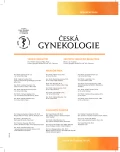Histopathological and clinical features of molar pregnancy
Authors:
J. Heřman 1; Lukáš Rob 2
; Helena Robová 2
; V. Drochýtek 2
; Martin Hruda 2
; Tomáš Pichlík 2
; P. Kujal 1; Jana Drozenová 1
Authors‘ workplace:
Ústav patologie 3. LF UK a FN Královské Vinohrady, Praha, přednosta prof. MUDr. R. Matěj, Ph. D.
1; Gynekologicko-porodnická klinika 3. LF UK a FN Královské Vinohrady, Praha, přednosta prof. MUDr. L. Rob, CSc.
2
Published in:
Ceska Gynekol 2019; 84(6): 418-424
Category:
Overview
Objective: To analyse own set of molar pregnancies and to develop clinically relevant procedures.
Type of study: Review article with analysis of own data.
Settings: Department of Pathology 3rd Faculty of Medicine, Charles University, Faculty Hospital Královské Vinohrady, Prague; Department of Obstetrics and Gynecology 3rd Faculty of Medicine, Charles University, Faculty Hospital Královské Vinohrady, Prague.
Introduction: The study monitors the decrease of laboratory values of beta-subunit of hCG gonadotropin (beta-hCG) after evacuation of partial and complete hydatidiform moles in a set of 45 partial and 46 complete moles. Two case reports of invasive moles.
Results: In cases of partial hydatidiform moles there was complete regression of beta-hCG in all cases, 89% regressed in six weeks, none of the women showed no subsequent elevation after reaching negativity. In cases of complete hydatidiform moles the decrease was less gradual, the negativity after six weeks was confirmed in 78%, three complete moles became malignant.
Conclusion: The decrease of beta-hCG after molar pregnancy termination is variable. Even if in cases of complete hydatidiform moles the risk of malignization after reaching negativity is low, beta-hCG checks are recommended at monthly intervals for 6 months. Correct diagnosis of complete mole and its differentiation from partial mole can be achieved using immunohistochemistry – p57 antibody.
Keywords:
histopathology – complete hydatidiform mole – partial hydatidiform mole – invasive mole – p57
Sources
1. Baergen, RN. Manual of pathology of the human placenta. 2. ed. New York: Springer, 2011, 544 p.
2. Dabbs, DJ. Diagnostic immunohistochemistry. 5. ed. Elsevier, 2018, 944 p.
3. Froeling, FEM., Seckl, MJ. Gestational trophoblastic tumors: an update for 2014. Curr Oncol Rep, 2014, 16(11), p. 408.
4. Jagtap, SV., Aher, V., Gadhia, S., Jagtap, SS. Gestational trophoblastic disease – clinicopathological study at tertiary care hospital. J Clin Diag Res, 2017, 11(8), p. 27–30.
5. Korbeľ, M., Šufliarsky, J., Danihel, Ľ., et al. Výsledky liečby gestačnej trofoblastovej neoplázie v Slovenskej republike v rokoch 1993 až 2012. Čes Gynek, 2016, 81(1), s. 6–13.
6. Kubelka-Sabit, KB., Prodanova, I., Jasar, D., et al. Molecular and immunohistochemical characteristics of complete hydatidiform moles. BJMG, 2017, 20(1), p. 27–34.
7. Kurman, RJ., Carcangiu, ML., Herrington, CS., Young, R. (Eds). WHO Classification of Tumors of Female Reproductive Organs. IARC: Lyon 2014.
8. Sadler, TW. Langmanova lékařská embryologie. 1. ed. Praha: Grada, 2011, 414 s.
9. Yao, K., Gan, Y., Tang, Y., et al. An invasive mole with bilateral kidney metastases: A case report. Oncol Letters, 2015, 10(6), p. 3407–3410.
10. Zavadil, M., Feyereisl, J., Krofta, L., et al. Perzistující trofoblastická nemoc v Centru pro trofoblastickou nemoc v ČR v letech 1955–2007. Čes Gynek, 2008, 73(2), s. 73–79.
11. Zavadil, M., Feyereisl, J., Hejda, V., et al. Histologická diferenciální diagnostika hydatidózních mol a hydropických potratů. Čes-slov patol, 2009, 45(1), s. 3–8.
Labels
Paediatric gynaecology Gynaecology and obstetrics Reproduction medicineArticle was published in
Czech Gynaecology

2019 Issue 6
Most read in this issue
- Histopathological and clinical features of molar pregnancy
- Prenatally diagnosed patent urachus with umbilical cord cyst and early surgical intervention
- The incidence of gestational diabetes mellitus before and after the introduction of HAPO diagnostic criteria
- The effect of physiotherapy intervention on the load of the foot and low back pain in pregnancy
